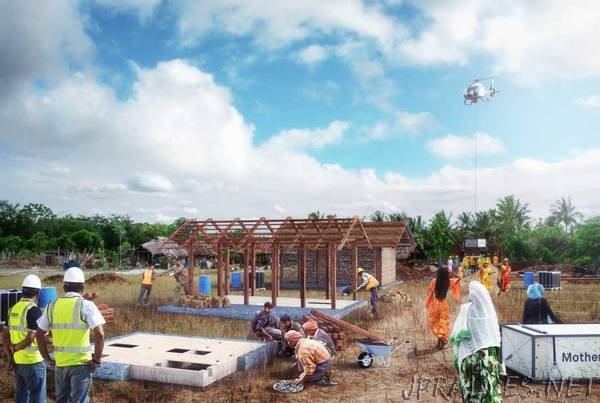
““Livingboard” is the prototype of a portable “motherboard system” to improve housing conditions in rural parts of India. A collaboration between international design and innovation practice Carlo Ratti Associati (CRA) and Indian non-profit organization WeRise, “Livingboard” encourages an open-source approach to design, allowing people to build their own dwellings on top of a prefabricated core. The first pilot is currently under study for development in the Indian state of Karnataka.
“Livingboard is a flexible ‘core’ system to support the development of housing initiatives in any rural area of the world. This core must be positioned horizontally, constituting the floor of a 12-square meter room (3x4m). It can provide, depending on the geography and infrastructure of the region in question, water storage and distribution, water treatment through filtration, waste management, heating, batteries to accumulate PV-generated electricity and wi-fi connectivity. Also, from a structural point of view, it provides seismic isolation by separating the building’s superstructure from the substructure,” writes CRA.
According to CRA, “Livingboard” revolves around the idea that housing should not be a static unit that is packaged and handed over to people, but rather should be conceived of as an ongoing project wherein the residents are co-creators.
“The Maker movement has shown how empowering it is to put the new fabrication tools in the hands of people,” says Professor Carlo Ratti, founder of CRA practice and Director of the Senseable City Lab at the Massachusetts Institute of Technology (MIT). “An important challenge for the next years will be to apply the same principle to construction – transferring the DIY attitude of Fab Labs to housing. This is the vision behind our design for ‘Livingboard.’”
Made of low-cost materials that can be flat-packed, “Livingboard” also pays homage to 20th century US inventor Richard Buckminster Fuller. In his 1969 book “Utopia or Oblivion,” Fuller wrote about his dream of “air-deliverable buildings,” by which he meant “whole cities can be flown to any location around the world […] just as fleets of ships can come in to port and anchor in one day, or be off for other parts of the world.”
CRA claims that “‘Livingboard” can potentially be carried by helicopters or even drones so as to reach any remote location.
The project continues CRA’s ongoing research in India and is strengthened by the collaboration with Italian non-profit organization “Mattone su Mattone,” which has been working to guarantee the right for any person to have a home.
Click on the slideshow for a sneak peek at the project.”
Link to article
